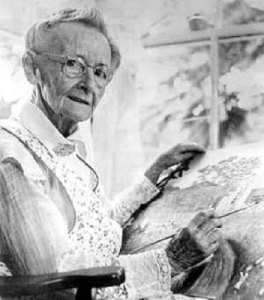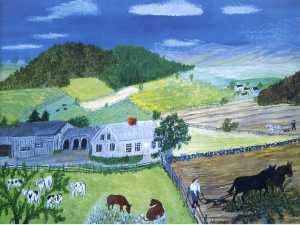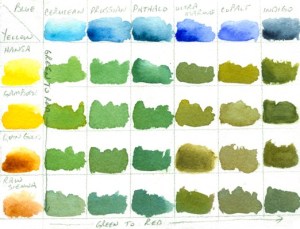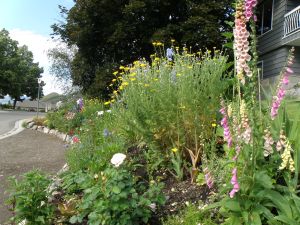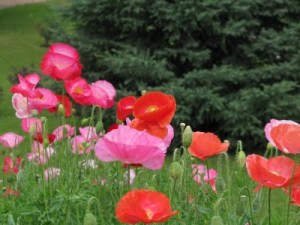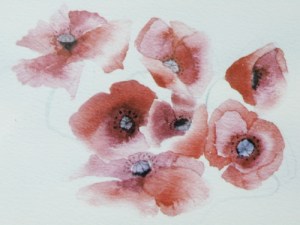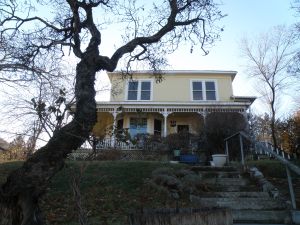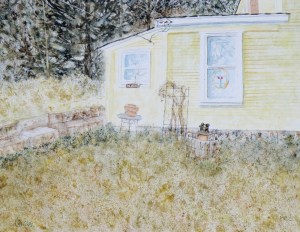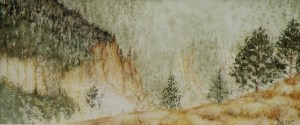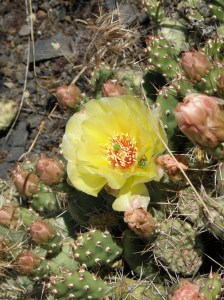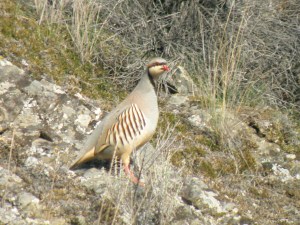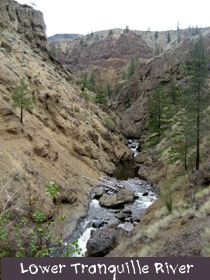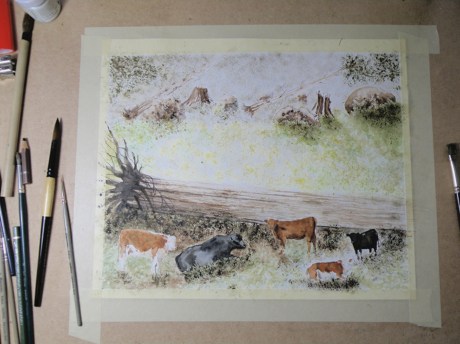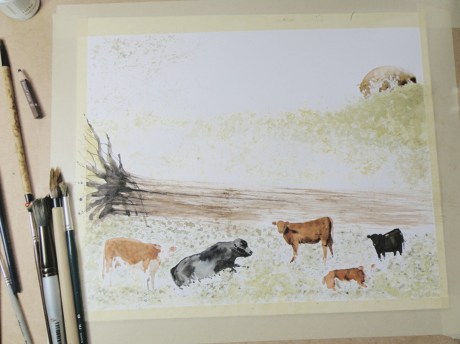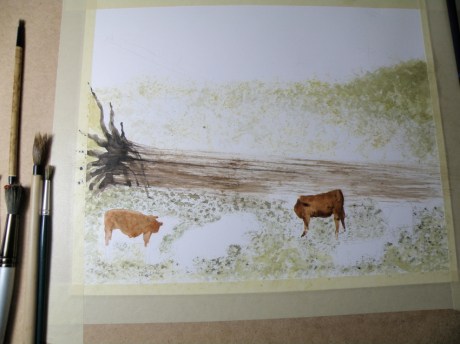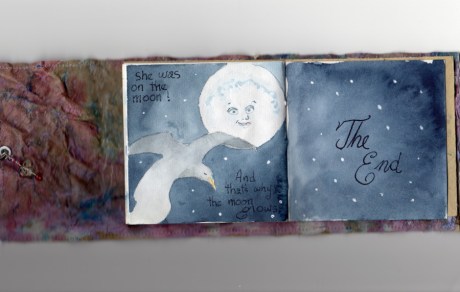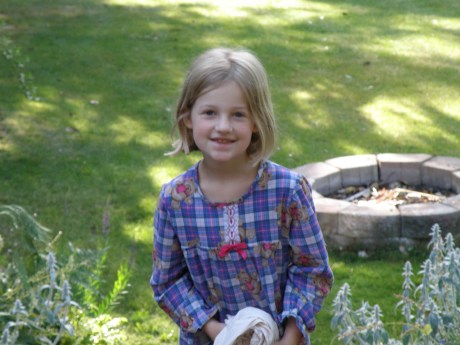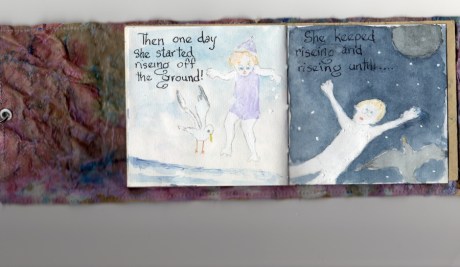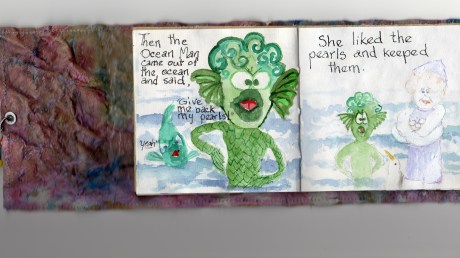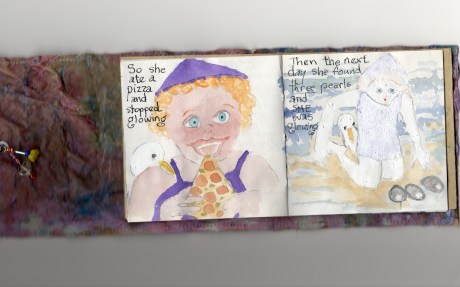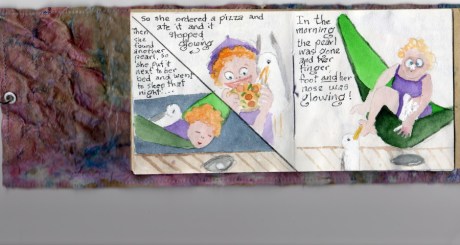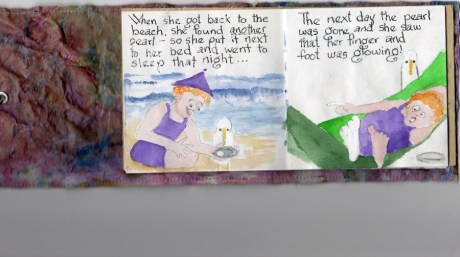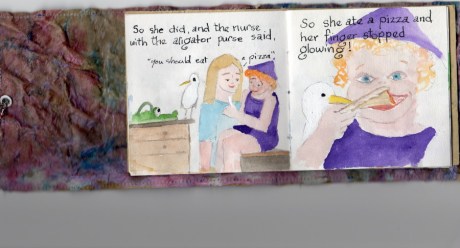Summer’s Zenith
August 5, 2020
We’ve been sizzling here in British Columbia’s Southern Interior. For the past two weeks, it has been very hot and very dry. This is when all the dirt bikes get loaded on the back of country music-blaring pickups, heading for the hills, bypassing all the slower, fishing boat-toting pickups. And even those pickups bypass the even slower camper trailer-toting pickups, with everyone and their dog all heading out of Dodge.
What’s left behind are solitary scenes of empty pasture, sun-weathered farms, the occasional horse. And not a lick of shade.

We’re at the apex of Summer–the zenith–with a high today of 35C (95F). And tomorrow? Well, tomorrow marks the slow slide into September, with showers and a high of only 23C (73F).
So today we pretend we’re Texans, and tomorrow that old familiar tinge of an early Fall brings us all back to where we really are and love to be.
….the silt bluffs
November 22, 2015
An area east of Kamloops, B. C., follows the South Thompson River which flows between dramatic limestone cliffs originally formed (it is estimated) 270 million years ago.
Among those cliffs is a gully–a waterworn ravine known as ‘the silt bluffs’, featuring very distinctive rock formations which have the look and feel of something out of a Western movie.
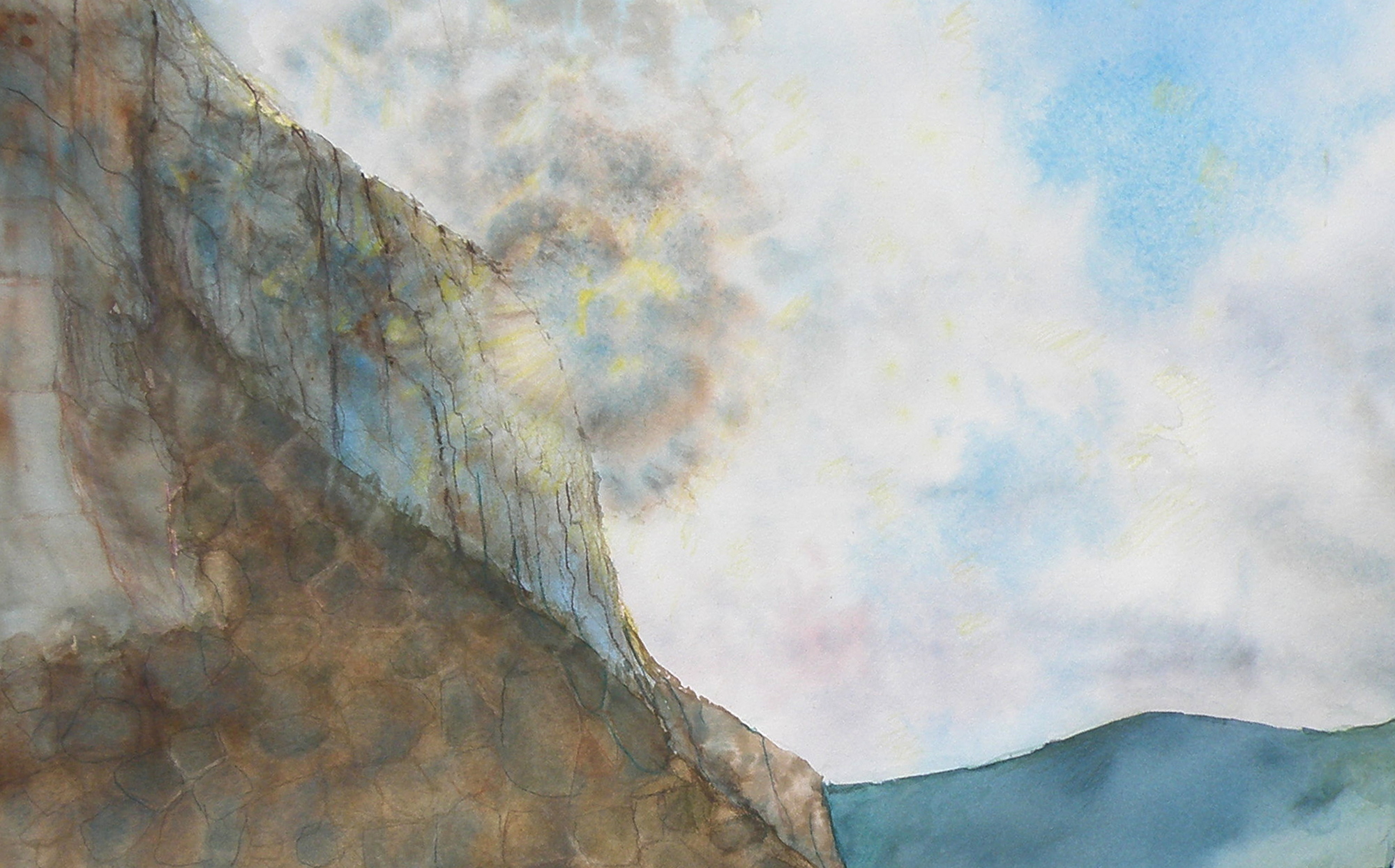
Massive geological formations such as these require some form of treatment by a painter in order to adequately convey their uniqueness and grandeur. This watercolour attempts to do that by purposely choosing to paint directly into the sun.
This part of our landscape gets quite literally baked by heat at midday, so when painting outdoors it is important to get it done quickly.
hot
August 24, 2015
This has been one. hot. summer. Right now smoke from fires burning on the Washington State/Canada border is blowing up our way due to Southwest winds. It’s an acrid, doused campfire smell and hazy even when just looking across the street.
‘The Silt Bluffs, Kamloops’, watercolour on Hot Press #140 Arches, 19cm x 24cm, (7.5″ x 9.5″) sold
Oh yeah. I’m done. Bring me a nice serving of September.
it’s not easy being….
August 18, 2015
The beauty of people is that though 99.9% the same, we all know it only takes going to, say, The Iowa State Fair, to discover we’re probably not. All you have to do is stand aside (wondering what on earth you bought that hot dog and sauerkraut for) and watch everyone passing by.
This is just a convoluted way of confessing that not everyone is a great fan of Summer. Painters (some painters who write certain blogs about watercolour) in particular who like landscapes can (on occasion) find Summer just too, um, well, green.
There are ways of uncomplicating all the greens. When I lived in The Adirondacks of New York, not far from our town, in another small town, the famous Grandma Moses, who began painting at the age of 78 had only recently died at the age of 101 .
She was once found in her studio with masonite panels at her feet and a roller with blue paint. Looking up from coating a panel and filling the roller with more blue from the tray, she informed her visitor, “On Thursdays I do skies.”
In 2006 one of her pieces sold for $1.6 million.
Greens can be as simply applied to a landscape as opening up a tube of something and rolling it on. In representational forms of art, trying to authenticate the many greens of a summer scene can be a complex challenge, if for no other reason than that there are just so many variations. Leaves on the very same tree play on different greens, without even mentioning the grasses, shrubs, bushes, ferns below it.
Because it is a colour derived from mixing blues and yellows, greens straight from the tube nearly always have a garishness when, for example, painted against a very blue sky. That’s because the blue of the sky likely isn’t the same blue used to create that particular green. If the sky is cerulean, mixing a green from cerulean and a yellow used in another part of the painting will harmonize. So finding ways to harmonize greens through using their primary parents elsewhere in the painting is a way forward–a way of conquering ‘the greens’.
A worthwhile exercise from a contributor named ‘CharM’ on the site http://www.wetcanvas.com, posted in 2011, is provided by this chart:
‘CharM’ takes a similar exercise to completion here:
http://www.wetcanvas.com/forums/showthread.php?t=925152
While one is actually in the process of painting a landscape with a variety of greens, it is entirely possible to include in the painting all of the above blues, through washes, cloud shadows, sky and/or water, and generally just finding ways to get them all in there. Likewise, the full range of yellows can also find their way into the painting. Doing this then puts all the blues in the scene, as well as all the yellows, and sets the stage for being able to harmoniously use every single green (and more) shown on ‘CharM’s very helpful chart(s).
I still prefer doing fog, mist, moonlight, winter and early dawns (before green has a glimmer of a chance of making an appearance). And that’s fine, because we all know I am .001% different — or lived a past life on a Scotland isle, where being able to see beyond the front step meant it was a lovely day.
butterfly morning
June 18, 2015
Many butterflies have developed interesting ways of defending themselves from predators. One method is disguise, or “cryptic coloration”, where the butterfly has the ability to look like a leaf or blend into the bark of a tree to hide from predators. Another method is chemical defense, where the butterfly has evolved to have toxic chemicals in its body. These species of butterfly are often brightly colored, and predators have learned over time to associate their bright color with the bad taste of the chemicals. (source:http://www.defenders.org/butterflies/basic-facts)
As children, we chased them with homemade cheesecloth and coathanger nets, paying frequent visits to our neighbour’s butterfly bush which truly was just that. Of course, today they are no longer so abundant and butterflies are–I grew to know–best viewed while alive and gracing the perennials in the front yard.
shirley poppies
June 14, 2015
The Shirley poppy was ‘created’ circa 1880 by the Reverend William Wilks, vicar of the parish of Shirley in England. Rector Wilks found in a corner of his garden where it adjoined arable fields, a variant of the field poppy that had a narrow white border around the petals.
By careful selection and hybridization over many years The Rev. Wilks obtained a strain of poppies ranging in colour from white and pale lilac to pink and red, and unlike the wild poppies these had no dark blotches at the base of the petals. (source: https://en.wikipedia.org/wiki/Shirley_Poppy, photo credit: http://pantip.com/topic/30827995)
THEY HAVE BECOME SYNONYMOUS with the Remembrance Day poppy, worn in lapels all over Canada and the U. K. in the early days of November onwards through to the 11th, post-memorial cenotaph services, where, in Canada’s capital, people place their poppy on The Tomb of the Unknown Soldier before departing.
joan’s place
June 7, 2015
THIS FORMAL AND RATHER LOVELY Heritage Home in our small city (90,000) of Kamloops, B.C., (canada) is known as the Dr. M.S.Wade House. Dr. Mark Wade was an eye, ear, and throat specialist who arrived in Kamloops in 1895. A decade later, in 1905 he built his home. It has become a great favourite painting subject of mine . . .
THE BASIC SHAPE OF THE HOUSE is undecorated and angular, but Wade added rich Victorian millwork and slender, turned verandah columns. Bay windows, stained glass and a wraparound verandah are lovely features to this home.
IT IS SUCH AN APPEALING SUBJECT. The reasons for this are my enjoyment of Victorian architecture, how the many nuances of this design capture the imagination, (especially when situating the house in the midst of ‘moody’ seasonal weather), and how its present owner adds her own personal touches. The watercolour below has been posted here, but some years ago now. . . .
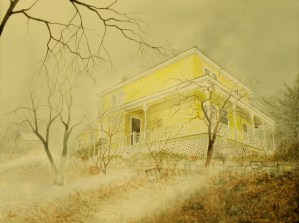
‘Foggy Dew’, November, Dr. Wade Home’, watercolour, Arches 140# Cold Press Paper, 36cm 50cm (14″ x 20″), J. Potter Collection
BUT A MORE SUMMERY ONE is of a portion of the house at the very back which can be faintly seen at the far left in the painting above . . .
“Joan’s Place”, watercolour on matt board, 23cm x 31cm (9″ x 13″)
THIS WAS AN EXPERIMENTATION in depicting grasses on the almost glassy smoothness of plain old white matt board. As a finished painting, it is so-so. The composition suffers from there being just a bit too much grass, and how the lawn ornaments unintentionally became the subject. Without an interesting focal point, in the end it was a helpful study in summer grasses and pines–and an instruction in what to avoid in seeking good composition (i.e. not everything in a photograph needs to be included).
tranquille creek gorge
June 3, 2015
ANCIENT FLOWS OF LAVA have left our regional landscape (Kamloops, B. C.) with dramatic canyons, a single lane dirt road skirting the edges.
MY PAINTING FRIEND MAX drove me through this arid landscape, only 10 minutes outside a city of nearly 100,000. Every so often she’d tell me of cars which had not been successful at executing a snowy, icy, tricky piece of road only to careen down the sides. At one place, the car was still there, making me both dizzy and almost nauseous, leaning over to see its rusting bulk caught between broken pines and rock.
‘MY GOD, WHERE WERE THEY HEADED?’ I’d asked. ‘Home, of course’, Max pointed ahead. And there was a small grouping of houses not far from the road, some fencing in horses or livestock–one had alpacas–and looking semi-deserted, though that was far from the case. Dogs barked at Max’s pickup as we threaded through and headed into yet more wilderness. ‘They take this road to Kamloops and back?’ — it seemed to my chicken, urban-minded guardedness a scary place to build one’s home. ‘Only for shopping, or a night on the town’, Max said. ‘Which is why someone sometimes doesn’t make it home–especially in the Winter.’
wee glimpses
May 26, 2015
PAINTING OUTDOORS has a way of getting a person to make judgment calls quickly, and in our area it is quite simply the heat of the day.
KAMLOOPS, B.C., IS UNIQUE IN THAT its mountainous hillsides are grass-covered with considerable sagebrush but little tree growth to the 900m level, creating what is known as an inverted tree line.
IN MOST PLACES TREES WON’T GROW above a certain level due to the lack of precipitation, but in Kamloops, they won’t grow below a certain level due to the lack of precipitation. We are known as The Sunshine Capitol of Canada, receiving over 2,000 hours of sun annually.
IOW, IT IS HOT. And since sun and heat are our landscape’s signature features, painting a local watercolour outdoors demands sitting right the heck out there.
THAT IS WHY IT MAKES GREAT SENSE to me to choose to do this by way of painting miniatures.
MINIATURES demand quick thinking and choosing the elemental–the scene’s compositional essences–getting them down efficiently and thoughtfully, though, at the same time, quickly.
A GOOD MINIATURE can serve as the template for a much larger, studio piece. And good miniatures stand up very well all by themselves. This particular one has been accepted into two different juried Federation of Canadian Artists Shows, including the annual ‘Small, Smaller, Smallest’. It was, in that show, the very smallest of the lot. And that made me very happy!
mountain storm
May 24, 2015
MOUNTAIN STORMS ALWAYS COME WITH high winds and occasionally with hail, and here in Kamloops, British Columbia, are often felt in one part of the city and not in others. Being a city of roughly 90,000, built around, about, and on top of mountainous terrain, the overall elevation is about 350 meters (1,125 ft). There can be terrible flashes and crashes and gusts–much huffing and puffing–with the promised deluge itself being delivered everywhere else but on our crispy, thirsty yard and gardens.
‘Summer Storm’
watercolour, 30cm x 23cm, (12″ x 9″), Arches Cold Press 140 lb. paper,
G.W. Weisser Collection
the tranquille creek gorge
May 16, 2015
THE SOUTHERN INTERIOR of British Columbia is a desert-like landscape, plunging steeply into geologically-unique valleys that include rattlesnakes, a ground-creeping variety of prickly pear cactus, sagebrush, and tumbleweed.
I ACCIDENTALLY DISCOVERED the local cacti by casually placing my hand on top of one in our backyard shortly after we’d moved to our current home.
OUR BACKYARD as such, is mostly mountain ridge, covered in these low-lying cacti, sagebrush, and outcropping of rock.
RUNNING UP AND DOWN OUR RIDGE are flocks of Chukar Partridges–a bird which belongs in ‘Roadrunner’ cartoons. Their name is derived from their ‘chuk-chuk-chuk-CHUK-CHUK-CHUKCHUKCHUKCHUK!!!’ call (who needs an alarm clock?). Below is a not-very-good photo of one (they are always on the run, making my camera skills not up to the task)….
NEARBY US is a very geologically-dramatic area called The Tranquille Creek Gorge.
PAINTING THIS TERRAIN ON LOCATION has to be done rather quickly (depending on the time of day), as temperatures can go up to 40C and the sun is relentless due to the lack of trees, and thus, shade….
COMING HERE FROM THE WET AND RAINY B. C. COAST, it has taken me years to come to fully appreciate the beauty of an arid area such as ours. But now that my eyes are open to the subtlety, I wouldn’t return to all that green for anything in the world. I’m happy in the depth of our browns (smile).
Silt Bluffs
April 26, 2015
THE KAMLOOPS REGION is a geological wonder. 50 million years ago, volcanoes erupted and volcanic ash and lava covered the land, and their record is preserved in fossil beds throughout the area. Ancient rivers carved the landscape, forming the modern valleys of the Thompson Rivers and, during the Ice Ages, ice sheets carved the valleys and rounded the plateaus and mountains in the Kamloops area. (sourced from ‘Tourism Kamloops’ website)
THIS PAINTING is of a local geological formation called The Silt Bluffs. In the height of summer they are baked by a 40C sun, and are the home of rattlesnakes and cacti . . . and Ravens.
“The Silt Bluffs”
23cm x 30.5cm (9″ x 12″), watercolour, 140 lb. Arches Hot Press Paper, sold
Finished work….”Logged-In”
April 16, 2015
painting progression 4 . . . “Cows”
April 15, 2015
THESE ARE BEEF COWS, Herefords, the breed most favoured by ranchers in our region. Their origins descend from small red cattle introduced by The Romans in ancient Britain, along with breeds from old Wales, their subsequent nurtured evolution taking place in Herefordshire where the Hereford is king. Today more than five million pedigree Hereford cattle exist in over 50 countries.
BECAUSE THE LARGE FALLEN CEDAR is indicated with only a minimum of brushwork it is necessary to help give it size, weight and substance through the simple use of shadow.
painting progression 3 . . . . “Cows”
April 14, 2015
THE SUBJECT MATTER comes from this photo, very quickly taken when we’d stopped the car on the dirt road running through The Dewdrop Valley (just outside the city limits of Kamloops) after I’d yelled, ‘Cows!’
This grouping was described to me by my friend Max as a perfect example of a bull and his harem–and the ‘harem’ got nervous and didn’t remain in place very long once I began snapping pictures. The bull couldn’t have cared less what I was up to, and just lay there chewing.
The very prominent tree in the painting is placed to provide focus. Rather than leave in the barbed wire fence (in front of them), a natural enclosure is placed behind to sneak a storyline into the scene (the best grass lies out of reach)—that, and taking out the wire fence gives a more natural feel to the setting.
IN THIS GRASS RICH region, cattle roam all over boulder-strewn and mountainous terrain throughout the Spring and Summer. They are finally rounded up on horseback in classic cowboy style in the Autumn. Because of this, the beef from Kamloops is renowned for its organic, grass fed superior flavour and quality.
painting progression . . . 2 “Cows”
April 13, 2015
THE PAPER IN USE HERE is a very smooth-surfaced one called Hot Press (140 lb.) by the French Company, Arches (a very old watercolour paper maker). Hot Press paper has virtually no surface texture at all and is slightly cream-toned. When papers are this smooth, the paint initially floats on top before being absorbed. This floating quality creates effects a rough surfaced paper can’t deliver.
So Hot Press paper looks and feels pretty much like dollar store poster paper–smooth, shiny, and about the same thickness. And because it is not a heavy paper, and because it is so smooth, Hot Press watercolour paper cannot take a lot of scrubbing out if mistakes are made. The painter needs to be rather confident about the strength and amount of pigment to use before putting brush to paper. So because I am always a bit tentative when beginning to paint something as challenging as an animal, I gain confidence by always having a scrap piece of watercolour paper handy to try things out on first. Once I see how to do it on a scrap piece of paper, then I have confidence to do the same thing on the painting itself.
It needs to be stressed that Arches paper is superb and bears absolutely no comparison to poster paper when paint is applied to it. The weight (140 lb) is how thick the paper is. 300 lb. paper is very thick and therefore can take a lot more scrubbing and multiple washes, without losing luminosity. The downside is that 300 lb. watercolour paper is quite a bit more expensive. And when I work on very expensive paper, I am too aware of its cost. That makes me somewhat nervous about possibly ruining the painting. So I usually choose 140 lb. paper because if it gets ruined, I am not that concerned, and so therefore approach the painting with more boldness which gives a better result.
Painting progression 1. . . ‘Cows’
April 11, 2015
THE DEWDROP VALLEY is a local site and part of a much larger area near Tranquille River and the Tranquille River Gorge. In essence, the Dewdrop is really rocky, hilly, grass-and-tree- covered pasture for cows and cattle during the Spring and Summer months. The Kamloops Thompson Nicola Shuswap Region is no-nonsense cowboy rancher country, complete with serious Rodeos and horse and rider cattle round-ups in the Autumn.
This is the first of recording daily progress towards completing a watercolour depicting a typical scene in The Dewdrop Valley . . . .
ON DISPLAY are a fine collection of tortured brushes. Some are from dollar stores or second hand bargain stores, and as soon as they get into the spare bedroom cum studio they’re cut up with scissors. None of them cost more than $2, and who knows what they’re made of–Moose? Sasquatch hair, perhaps. Each, however, is priceless.
The Federation of Canadian Artists’ National Show
April 7, 2015
THE FEDERATION OF CANADIAN ARTISTS had its beginnings in 1941, and had as its goal the unified representation of all Provinces through one organization. Canada’s premier artists, The Group of Seven, were instrumental in organizing The FCA, with A. Y. Jackson as the Ontario head, and Lawren Harris in charge of the West Coast region.
TODAY THE FCA has become largely a Western Canadian organization with most of its activity within the Province of British Columbia. The hub is Vancouver [www.artists.ca] with regional Chapters throughout B. C. and Southern Alberta. The Thompson Nicola Shuswap Chapter (which I am a member of) has been hosting two Annual Art Shows for many years, with the 2015 National Show being mounted this coming Wednesday, April 8th.
THE NATIONAL SHOW is open to any qualifying FCA member, but submissions for jurying are limited to 3. Digital images of a member’s work are submitted to Vancouver and juried by three Signature Artists who use a point system to arrive at which pieces will be accepted and which will be declined. Of the 130+ digital entries, only 85 pieces are selected for inclusion into this National Show.
MY OWN SUBMISSIONS (two) have been juried, one being accepted–
‘Approaching Storm, Sechelt’, 25cm x 35.5cm (10.5″ x 14″), Watercolour on board
It is considered an achievement simply to get into this Art Show, while Opening Night, Friday the 10th, will be the occasion when $2800.00 in Prizes are awarded by another set of Jurors for those paintings which stand out as the best of The Best. Only once has a piece of mine ever been awarded a prize.
SENIOR MEMBERS OF THE FEDERATION have these paintings being considered for The SFCA Prize, with only one receiving top honours.
NEARLY ALL THE WORK submitted by artists for these Shows is rendered in acrylics or oils, with some pastel, and a few watercolours, and fewer still graphite drawings. Watercolour, generally, is not the preferred medium of most painters. It is considered difficult and problematic because of its demands and limtations.

